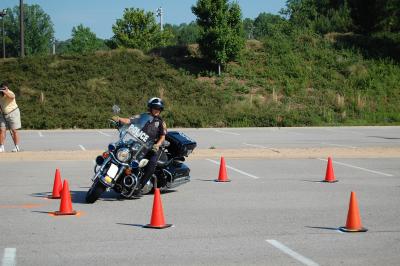Motorcycling is a mental exercise--the only physical part is picking up your bike
by Brendan

A Lady Motorcop in Action
The best advice I can give any beginning rider is to be familiar enough with the controls of your motorcycle so that you can use them without looking for them while riding and, while riding, to look in the direction that you want your bike to travel. If a hazard presents itself, debris in the roadway or a car cutting in front of your bike unexpectedly, look in the direction of your escape route. Don't lock in on the hazard. Your bike will go where you are looking.
Don't ride like Fred Flintstone. Your feet are not outriggers. If they hit something while hanging off your bike while you are moving, they will break and you will go down. At a minimum, hanging your feet out while taking off or slowing down will keep you from developing any sense of balance on your motorcycle. When you go, both feet need to be up on the footboards or pegs. When you stop -- and only when you are virtually stopped -- you put one foot down and one foot only. Normally that will be your left foot. Your right foot stays on the right peg/footboard and covers the rear brake lever/pedal to stabilize your motorcycle at a stop. The only exception to this would be if surface conditions would mean putting your left foot into an oil slick. In that case, you would put your right foot on the ground. Ever see a motorcop ride? The good ones ride like this.
Motorcycling means multi-tasking; performing a number of relatively simple tasks -- rolling on the throttle, engaging the clutch, easing off the rear brake and looking in the direction you want the motorcycle to go on a take-off for example -- simultaneously. Coordinating these tasks is the mental aspect of motorcycling. Really the only task that requires any true physical exertion is picking up your bike after you've screwed up. Let the bike do the work. Women riders tend to learn this earlier than men because most women realize that they do not have the upper body strength to muscle the motorcycle into doing what they want it to do. It's far easier (and safer and more efficient) to learn your bike's friction zone, use proper steering techniques (countersteer above 15mph, "direct" steer below 12mph), and use your motorcycle's torque to maneuver it through take-offs and turns.
Braking is the most important skill in riding a motorcycle. You must properly use your front brake and your rear brake together to stop your motorcycle safely in the shortest distance possible.
The rear brake is easy. The key is properly placing your right foot on the pedal/lever. You only need to rest your right big toe or a small portion of the leading edge of your right boot on the pedal/lever. The forward weight transfer during proper braking will automatically have you pushing your right foot down on the rear brake pedal/lever. The idea is to apply just enough pressure to the rear brake pedal to obtain rolling friction without locking up the rear wheel. If you put too much right foot on the lever/pedal or if you stomp on it, you will lock up the rear wheel.
The front brake provides the motorcycle with at least 90% of it's braking power. The key is to squeeze the lever progressively and not to snatch it suddenly. Squeeze the lever "like an orange." This is a two stage process. You first squeeze the lever progressively with about 50% effort. Your motorcycle's front end will dive, compress the front forks and "pancake" your front tire. This greatly increases the front tire's contact patch with the roadway surface. Once the forward weight transfer occurs, you continue to squeeze the brake lever progressively to the point of impending front wheel lockup. Some bikes provide an audible clue when you reach maximum threshold braking. The front rotors on a Harley Road King, for example, emit a tell tale whine when you achieve maximum braking on this bike.
If you lockup the front wheel, immediately release the front brake lever and properly re-apply the front brake.
You would NEVER immediately release the rear brake pedal/lever in a rear wheel lockup. There are two schools of thought on handling rear wheel lockups. The safest approach for the beginning rider is to leave the rear brake locked, straighten the bike out and ride it out the rear wheel lockup while properly using the front brake until the bike stops. A better approach for a more experienced rider would be to EASE off pressure to the rear pedal/lever until the bike regains rolling friction with the rear tire. The benefit of the first approach is that the rider can focus on proper front brake application and not worry about remedying the rear wheel lockup. The downside is that you give up 5 to 10% of your motorcycle's braking efficiency. The benefit of the second approach is that you try to regain 100% of your motorcycle's braking power (you may need it). The downside is that worrying about a rear wheel lockup at this point may distract a new rider from properly using the front brake. Proper braking techniques should be used at every stop sign or traffic light. If you use your brakes the right way under routine conditions, you will likely use the right techniques under stress.
|








